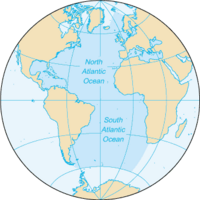
Photo from wikipedia
Abstract Cretaceous aged salt and salt-free basins along the continental margins of Brazil and Angola/Namibia exhibit a rather heterogeneous geometry and basin fill which implies a complex tectonic-sedimentary evolution. As… Click to show full abstract
Abstract Cretaceous aged salt and salt-free basins along the continental margins of Brazil and Angola/Namibia exhibit a rather heterogeneous geometry and basin fill which implies a complex tectonic-sedimentary evolution. As a consequence, the origin of the South Atlantic Aptian salt province has been widely discussed with rather contrasting concepts presented for the distribution of the salt depocentres relative to the protracted evolution of both continental margins. The work presented here aims on integrating conjugated basins transects with kinematic reconstruction models to evaluate the evolution and the geodynamic role of salt basins since the early opening of the South Atlantic. Comparing basin pairs along both margins reveals pronounced symmetry changes attributed to a shift in the spreading centre location from the South American to the African side, which at the same time explains changes in salt basin sizes, the continent/ocean crustal locations and seaward dipping reflector distributions. Furthermore, the arrangement of presalt sag sediments on subsiding, rifted continental crust in the proximal basins and newly formed proto-oceanic crust in the distal basins controlled the distribution and thickness of Aptian salt deposits. The subsequent structural and sedimentary record and the response of the salt systems in the South Atlantic indicate a prolonged history of spatial and temporal tectonic impacts that were rather unique for the individual margin segments. In particular phases of postrift margin uplift and tilting with associated salt tectonics and sediment deposition amplified structural differences in conjugated and neighboring salt basins. These also reflect the combined effects of plate tectonic and vertical motions with associated dynamic topography components along both South Atlantic margins.
Journal Title: Gondwana Research
Year Published: 2018
Link to full text (if available)
Share on Social Media: Sign Up to like & get
recommendations!